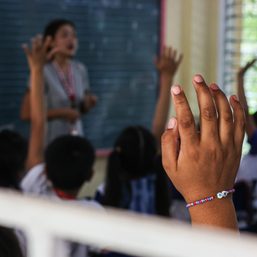SUMMARY
This is AI generated summarization, which may have errors. For context, always refer to the full article.

MANILA, Philippines – Economic uncertainties in recent years, even before the COVID-19 pandemic, caused Filipinos to deprioritize childbearing, a new study found.
The study, conducted by the Philippine Statistical Research and Training Institute and commissioned by the Commission on Population and Development (CPD), found that from around 2017, Filipinos opted to delay or deprioritize having children because of a perceived lack of financial capacity and a sufficient income.
When the trend emerged in 2017 and 2018, there was a decline in total registered live births from 1,700,618 to 1,668,120. Then, in 2019, there was a slight pick-up at 1,673,923, but the drop returned as the COVID-19 pandemic began.
In 2020, just 1,528,684 births were registered. A more significant drop came in pandemic year 2, at 1,364,739 births.
Births began to pick up again as lockdowns eased in 2022, when 1,455,393 births were registered.
The study analyzed the birth data together with focus group discussions and key informant interviews, which revealed Filipino couples’ decisions to not have children during the pandemic. These also showed more acceptance of modern family planning or birth control methods.
CPD Executive Director Lisa Grace Bersales said that the study supported the assumption that Filipinos, even before the pandemic, were already with the mindset of delaying “life-defining events such as dating, marriages, and having children.”
“These preferences were reinforced by the shocks in broader socioeconomic conditions, and the rise in the level of uncertainties in various aspects of the pandemic,” she said, adding that the commission was monitoring if these fertility behaviors have become the norm post-pandemic.
The Philippine Statistics Authority’s 2022 National Demographic and Health Survey similarly documented the drop in live births from 2017 to 2022, with the total fertility rate decreasing from 2.7 to 1.9 in those years.
During the COVID-19 pandemic, the Philippines was part of a global recession, with the economy taking a plunge to its worst contraction since World War II, with the gross domestic product falling by 9.5% in 2020.
The Philippine government’s social aid programs were not without blunders, causing millions of Filipinos to starve and struggle without work during the strictest lockdowns.
Increased contraceptive use
The study found that more Filipinos were using contraceptives, from 40% in 2017 to 42% in 2022, with the pandemic seen as a “key catalyst” for its usage.
Mostly women carried the burden of using birth control, as the study found that preferred methods were pills, female sterilization, and injectables.
From 2017 to 2022, Filipino women who wanted to have a child soon decreased from 15.1% to 13.9%.
“One positive result that came out from the pandemic was the more conscious consideration of couples’ and families’ socioeconomic capacities, as well as preparedness in their childbearing decisions,” said Bersales.
Bersales said that in the long term, the country can expect a larger aging population, a decrease in income tax collection, and a possible need to fill an impending workforce gap. – Rappler.com
1 comment
How does this make you feel?
![[ANALYSIS] End of growth: How the pandemic ruined PH economy beyond recognition](https://www.rappler.com/tachyon/2020/08/PH-recession-August-7-2020.jpg?fit=449%2C449)
![[EDITORIAL] Apat na taon na lang Ginoong Marcos, ‘di na puwede ang papetiks-petiks](https://www.rappler.com/tachyon/2024/07/animated-bongbong-marcos-2024-sona-day-carousel.jpg?resize=257%2C257&crop=280px%2C0px%2C720px%2C720px)
![[In This Economy] Delulunomics: Kailan magiging upper-middle income country ang Pilipinas?](https://www.rappler.com/tachyon/2024/07/in-this-economy-upper-middle-income-country.jpg?resize=257%2C257&crop=421px%2C0px%2C1080px%2C1080px)

![[EDITORIAL] Marcos Year 2: Hilong-talilong](https://www.rappler.com/tachyon/2024/07/animated-bongbong-marcos-2nd-sona-carousel.jpg?resize=257%2C257&crop=136px%2C0px%2C720px%2C720px)
![[Newspoint] A fighting presence](https://www.rappler.com/tachyon/2024/07/thought-leaders-a-fighting-presence.jpg?resize=257%2C257&crop=441px%2C0px%2C1080px%2C1080px)





Thanks to the Philippine Statistical Research and Training Institute and the Commission on Population and Development (CPD), the study found that from around 2017, Filipinos opted to delay or deprioritize having children because of a perceived lack of financial capacity and sufficient income. CPD Executive Director Lisa Grace Bersales also stated that “… in the long term, the country can expect a larger aging population, a decrease in income tax collection, and a possible need to fill an impending workforce gap.” It should be noted that the “perceived lack of financial capacity and sufficient income” is caused by this corrupt and repressive society, which uses disinformation to make people experiencing poverty believe that their lives have improved or are improving or will improve.